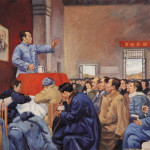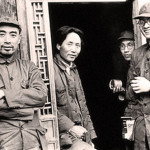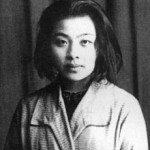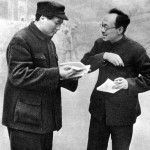
The Yan’an Rectification movement, or Zhengfeng, ran from 1941 to 1944. On the surface, rectification was concerned with educating the masses and purifying Chinese Communist Party (CCP) ideology. It began as a series of reflective study sessions, where individual party members studied the writings of Mao Zedong and engaged in reflection and criticism of their own attitudes. But Rectification was later exposed as a campaign to identify, marginalise, intimidate and remove party members opposed to Mao’s leadership and policies. Through this process, Mao was able to establish himself as the undisputed leader and figurehead of the CCP. Rectification cemented the party’s ideological direction for years to come, Mao’s own theories becoming the official ideology of the CCP. Though on the surface a political and intellectual movement, Rectification utilised terror tactics and produced violent outcomes. Though estimates vary, the purges carried out during Rectification caused as many as 10,000 deaths. Understanding Rectification is pivotal to understanding the development of the CCP and the leadership of Mao Zedong. It also provides a counterbalance to communist propaganda about the Yan’an Soviet, which is depicted as a period of optimism, cooperation and unity.
The seeds of Rectification can be found in the CCP’s struggles over leadership and ideology. After the Long March of 1934-35, surviving CCP cadres and Red Army troops established a new base in Yan’an in the northern province of Shaanxi. Mao Zedong had become the party’s undisputed military commander at the January 1935 Zunyi conference – but his leadership role in the broader party was less certain. The Yan’an period was one of relative stability and security; this gave Mao time and space to write extensively. In his Yan’an writings, Mao refined and articulated his own theories of revolution. He spent a great deal of attention distinguishing his own revolutionary theories from the writings of Marx and Lenin, and the views of pro-Soviet hierarchs in the CCP. The most significant of these was the ’28 Bolsheviks’ or ‘Returned Students’ faction, so named because they had studied at Sun Yixian University, a communist training academy in Moscow. The leader of this group, and thus Mao’s most powerful rival, was Wang Ming. A popular and respected Politburo member, Wang differed from Mao on questions of tactics and ideology. Along with the other ’28 Bolsheviks’, Wang Ming advocated a Soviet-style proletarian revolution, driven by the urban working class. He criticised Mao’s theory of peasant-driven revolution as deviationist.

The Rectification Movement unfolded in late 1941 as a campaign of thought reform. It enabled Mao Zedong, through his acolytes, to indoctrinate thousands of enthusiastic new CCP members arriving in Yan’an. The first phase of Rectification, a series of study sessions and group discussions, seemed benign. At these sessions, participants were required to show an understanding of Mao’s writings, which were required reading. They were then encouraged to undertake ‘self-criticism’ or ‘struggle’, in order to identify their misjudgements and free themselves from error. In the spring of 1942 participants were also invited to point out mistakes in the party, its tactics and operations, providing suggestions for improvement. When these volunteer critics emerged they were identified, rounded up and attacked for their individualism, for putting themselves before the party and the masses. Many party leaders demonstrated their loyalty by engaging in public confessions. One notable exception was Liu Shaoqi, who maintained that he was loyal to Mao. Mao himself made only a small gesture of ‘self-criticism’ in 1944, admitting only to “some excesses” in allowing party purges.

Two notable victims of the Rectification movement were writers and intellectuals Wang Shiwei and Ding Ling. Wang, an essayist with the newspaper Liberation Daily, was singled out for ‘struggle’ after writing Wild Lillies, an essay that criticised Mao’s sexual appetites, along with the other privileges and indulgences enjoyed by high ranking CCP members. Wang was accused of being a Trotskyite and arrested; he was executed in 1947 at Mao’s orders. Ding Ling, for a time a supporter of Wang Shiwei, was a respected feminist writer. She joined the CCP after the Nationalists murdered her husband. In 1942 Ding, frustrated by the double standards and gender inequality she saw in Yan’an, penned an article for a party newspaper. In it, she challenged the CCP’s position on equality for women. Ding was hauled before a public ‘struggle session’ and forced to retract her views. She became a celebrated writer but was later jailed as a rightist in 1957. Wang Ming, the leader of the ’28 Bolsheviks’, was marginalised and silenced by Mao’s supporters in 1941. During the Rectification campaign, Wang was subjected to public humiliation, though his position in the party allowed him to escape torture and execution.
“There was no doubting how far he was prepared to go to enforce his authority. Members now held him in awe or in terror. Mao Zedong had become the Red emperor whose words and wishes were to determine the fate of China for the next thirty years. What all this suggests is that the sweetness and light which, according to the Communist legend, had prevailed at Yan’an was only half of the story. Behind the amity and comradeship that undoubtedly did exist was a darker, grimmer reality.”
Michael Lynch, historian
The second phrase of Rectification involved a terror campaign and a series of purges. They were overseen by Mao’s security chief Kang Sheng, who was famous for dressing in black, riding a black horse, carrying a black whip and being accompanied by a vicious black dog. Kang was brutal and calculating, skilled at levying false accusations and extracting false confessions. With Mao’s backing, he claimed the party was riddled with spies and conspirators and set about arresting, imprisoning and torturing them. More than 1,000 cadres were tortured, another 40,000 were dismissed from the Party. Some 20 per cent of the Politburo’s Secretariat was removed and up to 60 top party officials were coerced into committing suicide. A Russian Comintern agent present in Yan’an said the “cruel method of psychological coercion that Mao calls moral purification has created a stifling atmosphere… Under the protocol of criticism and self-criticism, the thoughts and aspirations and actions of everyone are in full view”. CCP members were urged to form ‘persuasion’ groups to find supposed spies and then, using whatever means possible, convince them to confess. This practice was extended to individuals, who were urged to betray disloyal family members or to coerce loved ones to confess.

This insidious campaign continued until late 1944 when a backlash started to form against Mao and Rectification. Mao cleverly shifted the blame onto work unit leaders and cadres, by cynically ordering an end to torture tactics. He sought to win back the falsely accused by stressing the need for research and investigation, instead of acting on baseless accusations. His authority now cemented, Mao called a halt to the Rectification movement. Many historians believe the tactics of Rectification reappeared in future mass campaigns, such as the Hundred Flowers Campaign (1956-57), the Anti-Rightist Campaign (1957-59) and the Cultural Revolution (1966-76). Historian Chen Yungfa claims that “rectification had not changed from the 1940s to the 1960s, only its victims and [the] scale of victimisation. The Yan’an Way was not lit by beacons of hope but by storm lamp and danger signals”. For ordinary party members, the experiences of Rectification set clear parameters with regards to allowable political dissent and discussion. Rectification also centralised power within the CCP, increasing Mao’s stranglehold on political and military authority and the ideology of the party.

1. The Rectification Campaign of 1941-44 enabled Mao Zedong to consolidate his position as party leader, through a process of thought reform, ‘struggle sessions’, public intimidation and systematic purges of CCP members.
2. Rectification was a response to Mao’s leadership being threatened by political rivals within the party, particularly those who favoured a Soviet-style proletarian revolution rather than one led by the peasantry.
3. Initially, the Rectification movement involved sessions to study Mao’s writings and engage in self-criticism. Later they developed into a witch hunt of falsely accused spies and traitors.
4. The purges, overseen by Mao’s security chief Kang Sheng, were often brutal. Members were imprisoned, tortured and even executed, while many committed suicide.
5. Rectification ceased when Mao had re-established and increased his authority. It paved the way for similar rectification campaigns in decades to come, such as the Anti-Rightist Movement and the Cultural Revolution.
© Alpha History 2018. Content on this page may not be republished or distributed without permission. For more information please refer to our Terms of Use.
This page was written by Rebecca Cairns. To reference this page, use the following citation:
R. Cairns, “The Rectification movement”, Alpha History, accessed [today’s date], https://alphahistory.com/chineserevolution/rectification-movement/.
This website uses pinyin romanisations of Chinese words and names. Please refer to this page for more information.
